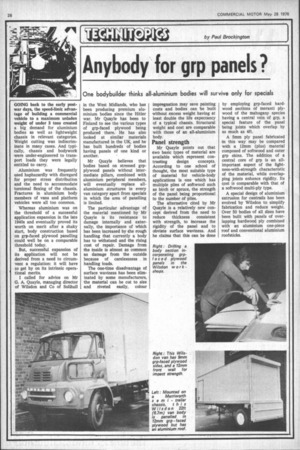Anybody for grp panels?
Page 28

If you've noticed an error in this article please click here to report it so we can fix it.
One bodybuilder thinks all-aluminium bodies will survive only for specials
GOING back to the early postwar days, the speed-limit advantage of building a commercial vehicle to a maximum unladen weight of under 3 tons created a big demand for aluminium bodies as well as lightweight chassis in relevant categories. Weight cutting was indiscriminate in many cases. And typically, chassis and bodywork were under-engineered to transport loads they were legally entitled to carry.
Aluminium was frequently used haphazardly with disregard for proper stress distribution and the need to accommodate torsional flexing of the chassis. Fractures in aluminium body members of vans and platform vehicles were all too common.
Whereas aluminium was on the threshold of a successful application expansion in the late 1940s and eventually proved its worth on merit after a shaky start, body construction based on grp-faced plywood panelling could well be on a comparable threshold today.
But, successful expansion of its application will not be derived from a need to circumvent a regulation: it will have to get by on its intrinsic operational merits.
I called for advice on Mr G. A. Quayle, managing director of Wilsdon and Co of Solihull
in the West Midlands, who has been producing premium aluminium bodies since the Hitler war. Mr Quayle has been to Finland to see the various types of grp-faced plywood being produced there. He has also looked at similar materials manufactured in the UK, and he has built hundreds of bodies having panels of one kind or another.
Mr Quayle believes that bodies based on stressed grpplywood panels without intermediate pillars, combined with aluminium peripheral members, will eventually replace allaluminium structures in every van category apart from specials in which the area of panelling is limited.
The particular advantage of the material mentioned by Mr Quayle is its resistance to damage internally and externally, the importance of which has been increased by the rough handling that currently a body has to withstand and the rising cost of repair. Damage from the inside is almost as common as damage from the outside because of carelessness in handling loads.
The one-time disadvantage of surface waviness has been eliminated by some manufacturers, the material can be cut to size and riveted easily, colour impregnation may save painting costs and bodies can be built Without excess weight having at least double the life expectancy of a typical chassis. Structural weight and cost are comparable with those of an all-aluminium body.
Panel strength
Mr Quayle points out that two basic types of material are available which represent con trasting design concepts. According to one school of thought, the most suitable type of material for vehicle-body applications is one which has multiple plies of softwood such as birch or spruce, the strength of the panel being proportional to the number of plies.
The alternative cited by Mr Quayle is a relatively new concept derived from the need to reduce thickness consistent with strength, to increase the rigidity of the panel and to obviate surface waviness. And he claims that this can be done by employing grp-faced hardwood sections of meranti plywood of the mahogany species having a central vein of grp, a special feature of the panel being joints which overlap by as much as 4ft.
A 5mm ply panel fabricated in this way may be compared with a 12mm (plus) material composed of softwood and outer grp skins. The addition of a central core of grp is an allimportant aspect of the lightness-with-strength characteristic of the material, while overlapping joints enhance rigidity. Its cost is comparable with that of a softwood multi-ply type.
A special design of aluminium extrusion for =trails has been evolved by Wilsdon to simplify fabrication and reduce weight. Over 50 bodies of all sizes have been built with panels of overlapping hardwood ply combined with an aluminium one-piece roof and conventional aluminium roofsticks.




















































































